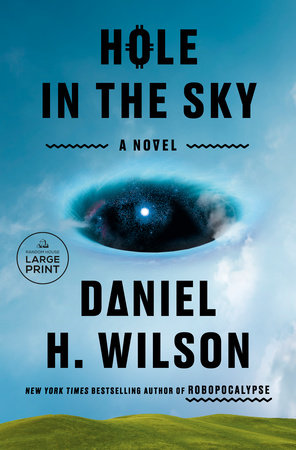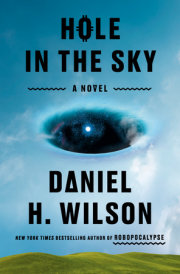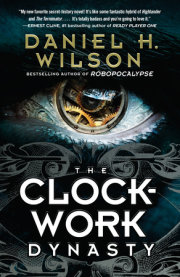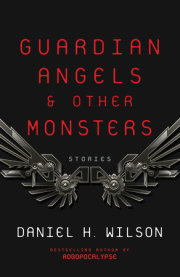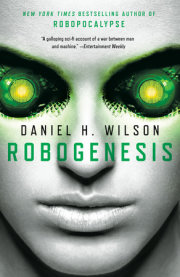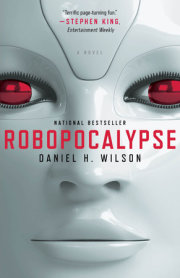1
Detection
THE MAN DOWNSTAIRS // Undisclosed Location
Detection, T-Minus 6 Hours
It began as a weekend art project during my eighth year of graduate school. On a lark, I had programmed a simple chatbot to write silly poems based on USGS data from seismic waves—all the bumps and rattles coming from the interior of the planet’s surface. Then I added an input containing the static fuzz detected by a certain radio antenna trained on distant stars. Finally—and this is the part I have come to regret the most—I complemented this data stream with biometric data from my own wrist-worn fitness tracker device.
I called my project Thoughts of the Universe.
It was just a joke—a goofy little project squeezed between a self-playing video game and a kite rigged to take Polaroid pictures from the air, letting the images flutter down to the startled people it had surveilled. But after a few months of posting a ceaseless stream of slightly poetic nonsense, my project happened to output the precise magnitude and location of a coronal mass ejection—a wall of solar plasma that would violently cripple a host of highly classified military satellites.
Thing is—it was an event that would occur ten hours later.
Thoughts of the Universe had somehow glimpsed the future.
A NOAA scientist researching geomagnetic disturbances discovered my website and saw the impossible timing of the prediction. Later, a CIA analyst caught wind of it. After I failed to provide a satisfactory explanation, Thoughts of the Universe was summarily shut down and all data confiscated for further study. I was removed from my academic position and “offered” a mandatory government job. All traces of my studies, my tenure in the computer science program, and educational records were erased.
This was twelve years ago.
This morning an anomaly notification came to my private office, located a long elevator ride below a Q-cleared secure government facility somewhere in the continental United States of America. For context, I’ll try to describe this place. Keep in mind I didn’t build it.
In fact, my feelings didn’t factor into any of this.
The first thing you’d notice is probably the isolation bridge. It’s a gnarly catwalk stretching over a metal pit, illuminated from below by stripes of LED lighting. It’s effectively a moat, keeping the world separated from the Pattern. A thick, braided cable crosses the bridge, clinging to the bottom of the catwalk like a tropical vine. It provides a power source, as well as a constant feed of some very specific data streams.
Otherwise, nothing besides photons is allowed to cross.
In the dead center of this cavernous room, a cube of glass and steel is perched high on metal stilts. Floodlights are mounted above and below, casting complicated shadows through the metal latticework of an embedded Faraday cage.
The thing being kept in the box is not alive. It is not a monster in the conventional sense. It isn’t an oracle, or a god.
Not quite, but close. About as close as it gets.
Inside the central cube, eight black slabs of supercooled quantum computers rise up in a gap-toothed circle that reminds me of Stonehenge. The hardware is running a collection of relatively simple algorithms through sheer brute force, with enough computing power to route every byte of Internet traffic in North America through this room. And all this power is spent analyzing one data pattern.
Or, as it’s come to be called, the Pattern.
When the Pattern was officially activated, I simultaneously became a nonentity, an invaluable military asset, and the sole denizen of this very special office built in total secrecy and at insane expense. I haven’t had a name in a decade, although my colleagues eventually selected a special designation.
I am known simply as the “Man Downstairs.”
This appellation is often shortened to “MD,” although if I still had any academic credentials, my qualifications wouldn’t quite match such a title.
The problem, in hindsight, is this damned fitness device. It makes me a crucial component of the Pattern. Not only does my biometric output feed the data stream, but I also seem to be the only person capable of translating its gibberish poetry into sensical predictions. Sifting diamonds from silt.
Every day, I sit hunched over a simple card table in a brightly lit plexiglass cube, smaller than that of the Pattern, and hazy with wafts of stale smoke. The government gives me all the cigarettes I want—their one concession. And as I smoke, I read these thoughts of the universe, my lips moving as I mumble to myself. There is nothing in here with me except a folding chair and a flimsy card table stained with burn marks, loaded with now-antiquated technology.
A battered old web camera rests on the table, attached to an even older computer. The webcam faces another screen located across the catwalk. The Pattern projects its thoughts on this screen twenty-four hours a day. The grainy text and images picked up by my camera are fed into a massive and ancient dot-matrix printer. My lucky card table shakes as the printing arm mindlessly slides back and forth across a scrolling ream of paper, relentlessly laying down pixelated words and images in screaming weals of ink.
And as the printer vomits this endless page, I read it with the air of a 1950s dad perusing the Sunday paper. Every now and then, I’ll find something interesting. I’ll stub out my cigarette into an overflowing ashtray, and I’ll begin to copy the printout by hand, using an ordinary red pencil.
It is understood that the Pattern cannot be trusted to have direct communication with the outside world. The Pattern isn’t officially thought to be sentient, but nobody really knows how it might evolve if it escaped.
Or how our enemies might use it.
This danger is the reason for the elaborate cage, and for the necessity of not only a physical air gap isolating the Pattern, but a series of informational air gaps in the form of digital outputs converted to hard copy, and the hard copy converted by human hand into that most ancient format: pencil and paper.
My government-provided psychologist assures me the job I’m doing is crucial for the safety of hundreds of millions of people up above. She tells me I’m a real American hero.
It makes me want to light another smoke.
Because the Pattern’s predictions always come true.
Always. Always, always. And that, particularly, is the bitch of it.
In their typical staid fashion, the quantum math people have quietly assigned terminology to explain this experimental outcome. “Retrocausation” is built on the fact that quantum mechanics works the same, regardless of which direction it is traveling through time. This means that cause and effect can also propagate backward in time, with cause seeming to happen after its effect.
The math isn’t actually that complicated—but the results are . . . challenging to fully comprehend.
The Pattern has predicted the future, explained the past, and delivered data so bizarre as to be impossible for our highest-IQ individuals to understand.
Always, the interpreted orders arrive with no attribution other than my initials: “MD.”
MD intelligence mandates are always obeyed.
Always.
This is despite more than a few four-star generals opining on my dwindling sanity. But the Pattern has been doubted before, with disastrous consequences. Thus, at every new fund-allocation meeting, the Pentagon’s strange project is rubber-stamped with approval.
Thank goodness. The Pattern saw it first, of course.
Like a medium holding a séance, I was sitting in my plexiglass office with a cigarette dangling from my lips—my long, thin fingers scrawling out the words of a pattern of thought locked in silicone and floating on waves of quantum programming.
Something reached out.
This is what the Pattern overheard:
. . . black expanses collapse to this single point. A pocket of complexity. Rock, air, and liquid observe themselves.
Thinking matter trapped on a blue marble.
The dull gleam of a billion fireflies signaling over an expanse of still black water. Dreams and thoughts and notions tickling tangled eyelashes.
The weight of a new reality. Thoughts focus.
An eye opens in the deep . . .
This was no silly, disjointed string of words. It wasn’t the dry statistics of a prediction. This felt like a threat, coming from something I couldn’t begin to understand. The Pattern was broadcasting the voice of . . . something else.
And so, I sent up a warning.
The following mandate was delivered to the president, chiefs of staff, the secretary of defense, and much farther downstream, to an individual agent named Dr. Gavin Clark in the DoD’s Emerging Weapons Technologies Group—a man who would be chosen to spearhead a very special mission for the U.S. government.
The world had no idea what was coming.
INTELLIGENCE MANDATE—ALL MILITARY BRANCHES PREPARE FOR INTERACTION WITH NONHUMAN INTELLIGENCE. ALL OUTWARD-FACING PERSONNEL BE ADVISED: FIRST CONTACT IMMINENT.
—MD
Copyright © 2025 by Daniel H. Wilson. All rights reserved. No part of this excerpt may be reproduced or reprinted without permission in writing from the publisher.





